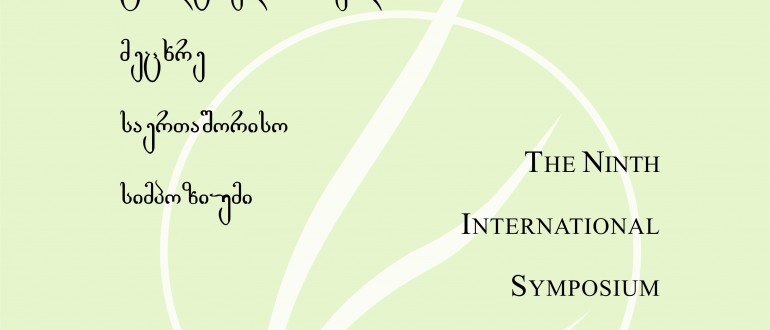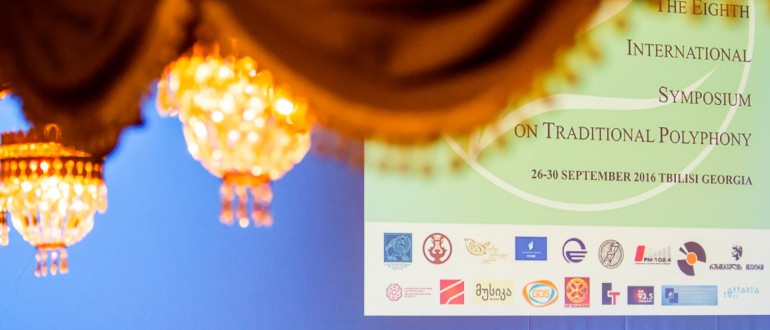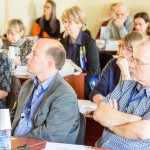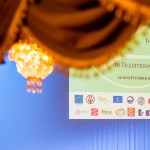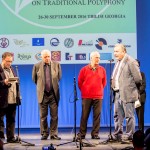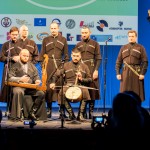On 30 October-3 November, 2018 Tbilisi State Conservatoire hosted the 9th International Symposium on Traditional Polyphony held by the Conservatoire, The International Centre for Georgian Folk Song, and Folklore State Centre of Georgia with the financial support of Georgia Ministry of Education, Science, Culture and Sport, under the patronage of President of Georgia.
Conferences, Seminars and Symposia on traditional polyphony
In this section the interested reader wiil find some information about the special conferences, symposia and seminars dedicated to the problems of traditional vocal polyphony. Of course, plenty of papers on different aspects of traditional polyphony have been delivered at countless ethnomusicological conferences all over the world, but here we discuss only the scholarly meetings that were fully dedicated to traditional polyphony. All the scholarly meetings discussed here had international participation.
Conferences, symposia and seminars on traditional polyphony, as we am aware, were organized in different countries from the 1960s, and became particularly widespread from the 1980s onwards. In this review we shall mention only the conference title, place, time, organizing body, names of the participants, countries they represented, and the titles of their papers. Some conference and symposia materials were not published at all, some were published as brief abstracts only, some were published as extended abstracts (from 2 to 4 pages), and some were published as collections of full papers (some even in more than one language).
As we know from all of these scholarly meetings, only one has been organized in Africa (symbolically, the very first one in 1966), and one in Southeast Asia (in 2002). Most of these conferences, symposia and seminars were organized in Europe. No such scholarly meeting dedicated to traditional polyphony has been so far organized in North and South America, or Australia. Scholarly meetings in this review are organized in chronological order.
8th International symposium on traditional polyphony Georgia, 2016
With the financial support of the Georgian Ministry of Culture and Monument Protection and Rustaveli National Scientific Fund, Tbilisi State Conservatoire, The Folklore State Centre of Georgia and the International Centre for Georgian Folk Song holded 8th International symposium on traditional polyphony at Tbilisi State Conservatoire. The Symposium was held under the patronage of Giorgi Margvelashvili, President of Georgia.
Among the participants of the 8th Symposium were 22 scholars from 21 countries of all 4 continents, including 15 Georgian researchers. Concerts of folk polyphony, held at the Grand Hall of State Opera House of Georgia, Recital Hall of Rustaveli Theatre and Recital Hall of the Conservatoire, add particular colour to the Symposium’s scientific sessions. The concerts were held with the participation of Georgian and foreign performers of Georgian polyphony, family ensembles, and ensemble Concordu Lussurzesu from Sardinia.
At the symposium were presented two films by Renato Morelli (Italy): “Two Generations of a Cuncordu Singing During Holy Week in Cuglieri (Sardinia, Italy) and “Mravalzhamier: a Singing Journey in Svaneti (Georgia) with Pilpani Family and Melbourne Georgian choir” and the film by Hugo Zemp (France) and Nona Lomidze (Austria/Georgia) “Table Songs in Kakheti”.
Singapore. 2016
Fourth Symposium of the ICTM Study Group on Multipart Music
Singapore, July 4-7, 2016
Programme Committee: Ardian AHMEDAJA (Austria), International Chairperson; Larry Francis HILARIAN (Singapore), Local Chairperson, Ignazio MACCHIARELLA (Italy), Zhanna PÄRTLAS (Estonia),
THEMES
- Multipart Music as a Mean of Social and/or Intercultural Interaction
When music is lively made, it is an interaction between behaviours put in place by distinctive persons on the basis of shared performative rules. Far from being an anodyne and faithful reproducer of sounds, every participant in the performative act is what he/she makes: he/she coincides with the vocal or instrumental sound he/she produces. As such, every participant in a performance is a soundful body who manifests his/her singular musicalitymore or less evidently and consciously, according to the shared music mechanism, to the circumstances and the purposes of the performance, on the basis of his/her music skills, background, taste, preferences and so forth. This is particularly true in multipart music practices which can be interpreted as conscious interactions between different sound identities.
What is polyphony, or how should we define it?
Polyphony is usually defined as a type of music, where more than one pitchis heard at a time. This definition of polyphony is one-sided and does not take into account a very important social aspect of vocal polyphony. I believe we must distinguish two equally important components of traditional vocal polyphony: social and musical. Social polyphony implies active musical interaction within the group of people. Musical polyphony implies having more than one pitch during performance. It is clear that traditional definition of polyphony is based on a musical component only and does not take social component into account. Social and musical aspects of polyphony do not always go together in various cultures. For example, the phenomenon of unison (octave) singing socially represents polyphony (as group singing), although musically it is monophony (only one pitch). On the other hand the unique overtone singing of some Central Asian cultures musically represents polyphony although socially it is not polyphony. Social polyphony is distributed extremely wide across the world musical cultures. Most of the so-called “monophonic cultures” (such as Chinese, Australian Aboriginal, or most of American Indian music cultures) have traditional forms of social polyphony (group singing). Arguably, there is no culture without traditional forms of group singing. One of the true universal phenomena of human musical cultures – antiphonal dialogue between two parties (two soloists, two groups, or more often between a soloist and a group) is the most basic and widespread form of social polyphony. Our review mostly deals with cultures where vocal polyphony is represented both by social and musical components. Regions where multi-part singing is represented by musical component only (without social component) are marked as having “elements” of vocal polyphony. Cultures with only social polyphony are not discussed in this article, but readers should remember that there is hardly any culture without social polyphony.
East Asia
Japan: Ainus
Arguably the most isolated tradition of vocal polyphony in the world is in eastern Asia, among the Ainus from the northern Japan and Kuril islands. Ainu ethnic, linguistic and even racial origins are much debated. The first Europeans who met the Ainus wrote that they looked like Finns. Later scholarly research confirmed the unique features of Ainu language and race. As arguably the first dwellers of this region (Sakhalin, Kuril Islands and particularly Hokkaido in Japan), the Ainus constitute the substrata of the Japanese.
About 20.000 Ainu live in northern Japan (mostly on Hokkaido) today. Only about one hundred of them can actually speak the Ainu language. After a five-year research program, conducted by the Japan Broadcasting Association in the beginning of the 1960s, about two thousand Ainu traditional songs were recorded. A 600-page volume “Music of the Ainu” containing about 500 transcribed pieces of music was published in Japanese with a small English summary (Kazuyuki, 1965).
The traditional polyphony of Ainu is based on canonic imitation of relatively short musical phrases. According to Kazuyuki (1965, 1975), out of thirteen different genres two are the most important: upopo (round, sung in a canon by elders sitting in a circle), and rimse (round dance, only very rarely sung as a canon). There is an interesting and complex interaction between these two genres: “The way in which these songs are handed down is in disorder today, and many songs are sung equally as upopo and rimse. Even in such instances, however, rimse is rarely sung in canon. Imitation is a significant criterion for judging rimse and upopo. The latter is sung imitatively by several people seated round the lid of a chest, tapping the rhythm on the lid. Usually the lead is taken by the oldest member of the group. The leader turns his face towards a man sitting at his right, and on a cue this man starts singing a beat behind. This continues until the last man sings while the rest go on singing. Thus the whole sound becomes chaotic and the sounds comply with the etymology of the word ‘upopo’, noisy singing like birds twittering. The whole process is repeated several times, and then the leader starts another song in like manner. The falsetto (pon) singing at the beginning of the song is very distinctive, and its effect is like lighting candles one after another in the dark. Upopo and rimse were originally the same as their etymology suggests; they only gradually achieved separate identities. The rimse became a dancing song, and the upopo became an imitation sitting song” (Kazuyuki, 1975:63).
Denmark and Norway
According to Giraldus Cambrensis, Denmark and Norway were two of the most important and influential centres for the dissemination of vocal polyphony throughout medieval northern Europe from Scandinavia to Iceland. Unfortunately, there is almost no other information on this topic from subsequent centuries. Although, interestingly, “The building blocks of Norwegian music – augmented fourth, parallel fifths and octaves, pedal points, asymmetrical rhythms” has some remarkable similarity with the main features of the singing traditions of twisongur polyphony from Iceland (see above). Considering the deep ethnic and cultural connections between Iceland and Norwegians, this is hardly surprising.
Denmark and Norway
According to Giraldus Cambrensis, Denmark and Norway were two of the most important and influential centres for the dissemination of vocal polyphony throughout medieval northern Europe from Scandinavia to Iceland. Unfortunately, there is almost no other information on this topic from subsequent centuries. Although, interestingly, “The building blocks of Norwegian music – augmented fourth, parallel fifths and octaves, pedal points, asymmetrical rhythms” has some remarkable similarity with the main features of the singing traditions of twisongur polyphony from Iceland (see above). Considering the deep ethnic and cultural connections between Iceland and Norwegians, this is hardly surprising.
Pacific Islands and Australia
Covering about half of our planet (but only a fraction of the world’s population), the Pacific Ocean is the home of an amazing richness of vocal polyphonic traditions. Both Marius Schneider in his 1934-1935 “History of Polyphony” and later Alan Lomax in his 1968 “Folk Song Style and Culture” placed the Oceania islands (particularly Polynesia and Melanesia) among the three most polyphonic major regions of the world (the two others being sub-Saharan Africa and Europe).
Polynesia
Perhaps one of the most important historical lessons that Oceania (and particularly Polynesia) taught European musicology (in the 18th century) was the shock of the discovery that well-organized part-singing can exist far from European civilization. The very first encounters of European travelers with the Pacific Ocean Island communities brought to light their strong predilection towards vocal polyphonic singing. From 1773 records come the following descriptions: “This set most of the women in the circle singing their songs were musical and harmonious, noways harsh or disagreeable”, or: “Not their voices only but their music also was very harmonious & they have considerable compass in their notes” (Beaglehole, 1962:246). Some descriptions are even more precise: “They sing in parts, keeping the same time and varying the four notes without ever going beyond them. So many singers and so few notes you always hear the whole together. The difference of Words & Voices makes some variety. The singers (that I heard) were all women. One confined herself entirely to the Lower Note which acted as Drone” – this eloquent description comes from Cook’s second 1772-1775 voyage (Burney 1975:84. Cited from Kaeppler et al., 1998:14). Very clear information on the Oceanic people’s part-singing capability came from Cook’s third voyage as well: “Where there is a great number they divide into several parts each of whom sings on a different key which makes a very agreeable music (Beaglehole, 1967:2:944. Cited from Kaeppler et al., 1998:14). Early records even indicated the use of unusual chords as well: “We now and then remarked some discordant notes, with which, however, the ear of these people seemed very much gratified” (Labillardiere, 1802:133). These and many other travelers’ notes did not leave a place for any skepticism about the wide distribution of a polyphonic singing tradition in Oceania before their first contacts with Europeans.
South America
It became a commonplace in ethnomusicological publications to note that South American Indians’ singing traditions contain much more polyphony than those of their North American counterparts. “In spite of the dearth of polyphony in North America, it has often been taken for granted that Central and South American Indians had complex polyphonic styles” (Nettl, 1961:354). According to Alan Lomax, “Polyphonic singing, which is frequently diffusely organized counterpoint, occurs in South America especially along the eastern slopes of the Andes. In this area too one encounters an unemphatic, soft-voiced, subdued, feminine-sounding style, with a frequent use of harmony. Such singing can be heard in the backwoods of highland Peru (Q’eros) and from the Campa of the eastern Andean slopes, through Venezuela and Colombia, into southern Mexico among the Tzotzil” (Lomax, 1968:85).
Q’ero
Probably one of the most interesting surviving musical traditions comes from the small tribe of Q’ero (about four hundred people only left), who live in the Cusco region of the Andes in Peru. Although some consider Q’ero to be Inca survivals, scholars think that Q’ero musical culture “probable reflects an even earlier diversity with an Inka overlay” (Cohen, 1998:225). Most importantly for our topic, the Q’ero have interesting and sometimes unique traditions of polyphonic singing. According to Cohen: “The general Q’ero musical aesthetics allows different pitches, texts, and rhythms to sound at the same time. Though the Q’ero sometimes sing in perfect unison, their songs are structures to be sung individually. There is no sense of choral singing or harmony. A family, aullu, or community may be singing and playing the same songs at the point of starting and stopping. Yet the melodies sung at communal occasions have a sustained note at the end of a phrase, permitting the other singers to catch up and share this prolonged duration, which serves as a drone. When the new verse starts, the heterophony begins anew” (Cohen, 1998:230).
Cohen describes the singing of women during the Palchasqa festival among Q’eros (held during February or March): “… several families join together outside and throw flowers (palcha) at the alpacas while singing and playing pinculu. Five or more women sing at the same time, interspersing ritual phrases with complaints about their daily lives. Each tells her own story in song. At times, the musical texture consists of different people singing personalized songs simultaneously. Only occasionally do they meet on ritual phrases or on final notes” (Cohen, 1998:228). Another interesting tradition is the big family singing sessions with the elements of drone polyphony: “twenty people may be packed together inside, drinking, singing heterophonically, with conch trumpets blasting. Sometimes, late in the night, the individual qualities become less apparent as people find accord between them, reaching a degree of musical consensus. At this point, the sustained final note of a phrase provides a drone beneath the individual voices. Occasional multi-part texture occurs, and the whole event takes on a choral sound” (Ibid, 229). Another interesting tradition of big communal singing happens during the carnival, where few groups of women sing in disregard of each other, together, while men play the musical instrument pinucllu. Cohen notes the closeness of this tradition to the celebration singing tradition of Amazonian Indians (ibid, 229).

